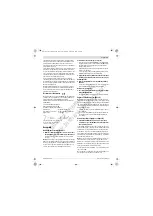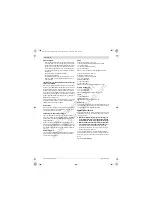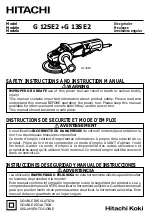
English |
17
Bosch Power Tools
3 609 929 C70 | (28.8.13)
protective equipment.
Fragments of workpiece or of a
broken accessory may fly away and cause injury beyond
immediate area of operation.
When using the pneumatic tool for the performance of
work-related activities, the operator may experience
unpleasant sensations in the hands, arms, shoulders,
neck area or other body parts.
Should the operator perceive symptoms such as persis-
tent nausea, discomfort, throbbing, pain, tingling,
numbness, burning or stiffness, these warning signs
should not be ignored. The operator should notify his
employer about the symptoms and consult a qualified
physician.
Do not use any damaged application tools. Before eve-
ry use, check application tools for chips and cracks,
abrasion or excessive wear. If the pneumatic tool or the
application tool falls, check whether it is damaged or
use an undamaged application tool. When you have
checked and inserted the application tool, keep your-
self and bystanders away from the vicinity of the spin-
ning application tool and leave the power tool to run for
a minute at maximum speed.
Damaged accessories usu-
ally break during this test time.
When you have checked and inserted the application
tool, keep yourself and bystanders away from the vicin-
ity of the spinning application tool and leave the power
tool to run for a minute at maximum speed.
Damaged ac-
cessories will normally break apart during this test time.
Prevent the end of the spindle from touching the base
of the opening in cup wheels, grinding cones or grind-
ing stones with threaded inserts intended for mounting
on machine spindles.
Do not use reducers or adapters.
Store abrasives according to the manufacturer’s speci-
fications.
Use appropriate detectors to determine if utility lines
are hidden in the work area or call the local utility com-
pany for assistance.
Contact with electric lines can lead
to fire and electric shock. Damaging a gas line can lead to
explosion. Penetrating a water line causes property dam-
age.
Avoid contact with
“
live
”
conductors.
The pneumatic
tool is not insulated; contact with a “live” conductor can
lead to an electric shock.
The dust developing during sanding,
sawing, grinding, drilling and similar
operations can act carcinogenic, teratogenic or mutagen-
ic.
Some of the substances contained in these dusts are:
–
Lead in lead-based paints and varnishes;
–
Crystalline silica in bricks, cement and other masonry
work;
–
Arsenic and chromate in chemically treated wood.
The risk of disease depends on how often you are exposed to
these substances. To reduce the risk, you should work only in
well ventilated rooms with appropriate protective equipment
(e. g. with specially designed respirators that filter out even
the smallest dust particles).
When working on the workpiece, additional noise can
develop, which can be avoided through appropriate
measures (e. g. by using damping materials on occur-
rence of ringing noise from the workpiece).
When the pneumatic tool is equipped with a silencer,
always ensure that it is available and in proper working
condition when operating the pneumatic tool.
Vibration effects may cause damage to the nerves and
blood circulation disorders in the hands and arms.
Wear close-fitting gloves.
The flow of compressed air
makes the handles of pneumatic tools cold. Warm hands
are less sensitive to vibrations. Loose fitting gloves can be
caught by rotating parts.
If you notice that the skin of your fingers or hands be-
comes numb, tingles, hurts or turns white, stop work-
ing with the pneumatic tool, notify your employer and
consult a physician.
To hold the weight of the pneumatic tool, if possible,
use a stand, a spring balancer or an equalizer.
An insuf-
ficiently mounted or damaged pneumatic tool may lead to
excessive vibrations.
Hold the pneumatic tool with a not too firm yet secure
grip, compliant with the required hand-reaction forces.
The vibrations can be intensified the firmer you hold the
tool.
When universal rotary couplings (bayonet couplings)
are being used, retaining pins are required. Use Whip-
check hose restraints to protect against failed hose
connections or the connection between hose and pneu-
matic tool.
Never carry the pneumatic tool by the hose.
Symbols
The following symbols could have a meaning for the use of
your pneumatic tool. Please take note of the symbols and
their meaning. The correct interpretation of the symbols will
help you to use the pneumatic tool in a better and safer man-
ner.
WARNING
Symbol
Meaning
Before installing, operating, re-
pairing, maintaining and replacing
accessories as well as prior to
working near by the pneumatic
tool, please read and observe all in-
structions.
Failure to follow the fol-
lowing safety warnings and instruc-
tions may result in serious injury.
Wear safety goggles.
W
Watt
Power output
Nm
Newton metre
Unit of energy
(torque)
OBJ_BUCH-2005-001.book Page 17 Wednesday, August 28, 2013 8:57 AM
Та
ше
в
-
Га
лв
ин
г
ОО
Д
www.tashev-galving.com
















































